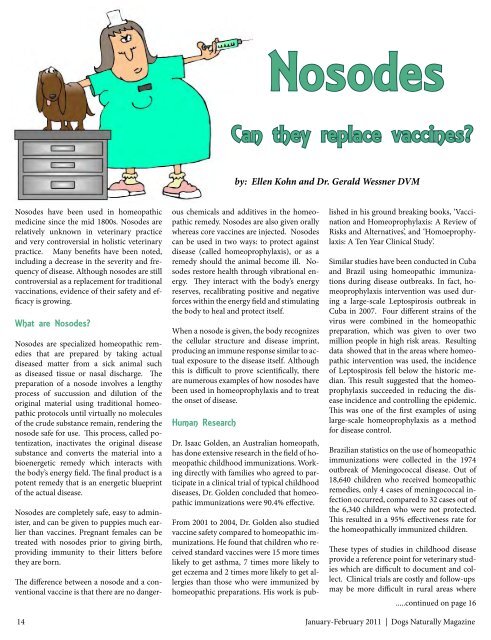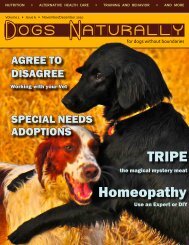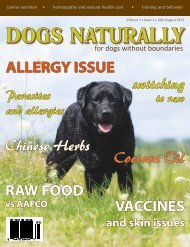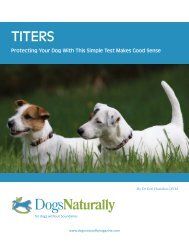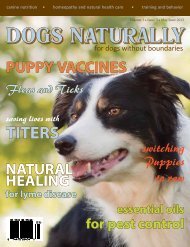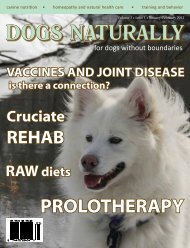January/February 2011 - Dogs Naturally Magazine
January/February 2011 - Dogs Naturally Magazine
January/February 2011 - Dogs Naturally Magazine
Create successful ePaper yourself
Turn your PDF publications into a flip-book with our unique Google optimized e-Paper software.
Nosodes have been used in homeopathic<br />
medicine since the mid 1800s. Nosodes are<br />
relatively unknown in veterinary practice<br />
and very controversial in holistic veterinary<br />
practice. Many benefits have been noted,<br />
including a decrease in the severity and frequency<br />
of disease. Although nosodes are still<br />
controversial as a replacement for traditional<br />
vaccinations, evidence of their safety and efficacy<br />
is growing.<br />
What are Nosodes?<br />
Nosodes are specialized homeopathic remedies<br />
that are prepared by taking actual<br />
diseased matter from a sick animal such<br />
as diseased tissue or nasal discharge. The<br />
preparation of a nosode involves a lengthy<br />
process of succussion and dilution of the<br />
original material using traditional homeopathic<br />
protocols until virtually no molecules<br />
of the crude substance remain, rendering the<br />
nosode safe for use. This process, called potentization,<br />
inactivates the original disease<br />
substance and converts the material into a<br />
bioenergetic remedy which interacts with<br />
the body’s energy field. The final product is a<br />
potent remedy that is an energetic blueprint<br />
of the actual disease.<br />
Nosodes are completely safe, easy to administer,<br />
and can be given to puppies much earlier<br />
than vaccines. Pregnant females can be<br />
treated with nosodes prior to giving birth,<br />
providing immunity to their litters before<br />
they are born.<br />
The difference between a nosode and a conventional<br />
vaccine is that there are no danger-<br />
ous chemicals and additives in the homeopathic<br />
remedy. Nosodes are also given orally<br />
whereas core vaccines are injected. Nosodes<br />
can be used in two ways: to protect against<br />
disease (called homeoprophylaxis), or as a<br />
remedy should the animal become ill. Nosodes<br />
restore health through vibrational energy.<br />
They interact with the body’s energy<br />
reserves, recalibrating positive and negative<br />
forces within the energy field and stimulating<br />
the body to heal and protect itself.<br />
When a nosode is given, the body recognizes<br />
the cellular structure and disease imprint,<br />
producing an immune response similar to actual<br />
exposure to the disease itself. Although<br />
this is difficult to prove scientifically, there<br />
are numerous examples of how nosodes have<br />
been used in homeoprophylaxis and to treat<br />
the onset of disease.<br />
Human Research<br />
Dr. Isaac Golden, an Australian homeopath,<br />
has done extensive research in the field of homeopathic<br />
childhood immunizations. Working<br />
directly with families who agreed to participate<br />
in a clinical trial of typical childhood<br />
diseases, Dr. Golden concluded that homeopathic<br />
immunizations were 90.4% effective.<br />
From 2001 to 2004, Dr. Golden also studied<br />
vaccine safety compared to homeopathic immunizations.<br />
He found that children who received<br />
standard vaccines were 15 more times<br />
likely to get asthma, 7 times more likely to<br />
get eczema and 2 times more likely to get allergies<br />
than those who were immunized by<br />
homeopathic preparations. His work is pub-<br />
Nosodes<br />
Can they replace vaccines?<br />
by: Ellen Kohn and Dr. Gerald Wessner DVM<br />
lished in his ground breaking books, ‘Vaccination<br />
and Homeoprophylaxis: A Review of<br />
Risks and Alternatives’, and ‘Homoeprophylaxis:<br />
A Ten Year Clinical Study’.<br />
Similar studies have been conducted in Cuba<br />
and Brazil using homeopathic immunizations<br />
during disease outbreaks. In fact, homeoprophylaxis<br />
intervention was used during<br />
a large-scale Leptospirosis outbreak in<br />
Cuba in 2007. Four different strains of the<br />
virus were combined in the homeopathic<br />
preparation, which was given to over two<br />
million people in high risk areas. Resulting<br />
data showed that in the areas where homeopathic<br />
intervention was used, the incidence<br />
of Leptospirosis fell below the historic median.<br />
This result suggested that the homeoprophylaxis<br />
succeeded in reducing the disease<br />
incidence and controlling the epidemic.<br />
This was one of the first examples of using<br />
large-scale homeoprophylaxis as a method<br />
for disease control.<br />
Brazilian statistics on the use of homeopathic<br />
immunizations were collected in the 1974<br />
outbreak of Meningococcal disease. Out of<br />
18,640 children who received homeopathic<br />
remedies, only 4 cases of meningococcal infection<br />
occurred, compared to 32 cases out of<br />
the 6,340 children who were not protected.<br />
This resulted in a 95% effectiveness rate for<br />
the homeopathically immunized children.<br />
These types of studies in childhood disease<br />
provide a reference point for veterinary studies<br />
which are difficult to document and collect.<br />
Clinical trials are costly and follow-ups<br />
may be more difficult in rural areas where<br />
.....continued on page 16<br />
14 <strong>January</strong>-<strong>February</strong> <strong>2011</strong> | <strong>Dogs</strong> <strong>Naturally</strong> <strong>Magazine</strong>


